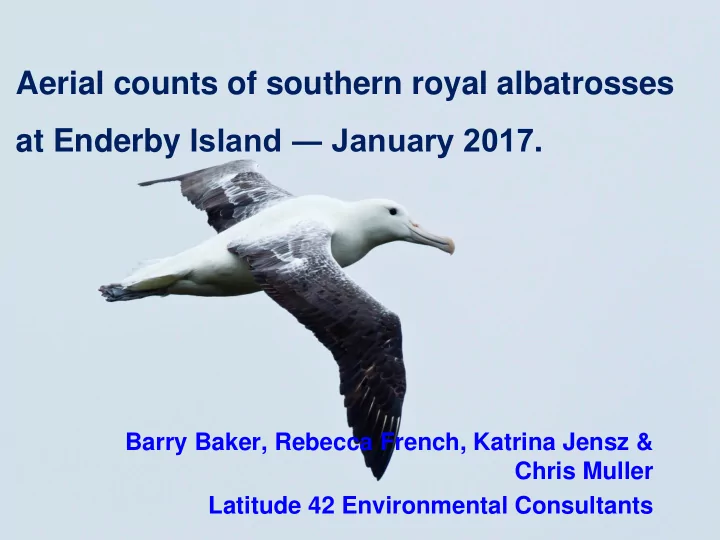

Aerial counts of southern royal albatrosses at Enderby Island ― January 2017 . Barry Baker, Rebecca French, Katrina Jensz & Chris Muller Latitude 42 Environmental Consultants
background ― accurate estimation of numbers critical for determining conservation status of any animal ― aerial photography increasingly preferred as census method of choice for surface nesting seabirds, especially in remote locations (Wolfaardt & Phillips 2011) ― applied to a range of colonially nesting albatrosses BBA, WCA, SA, GHA ― techniques still under development for loosely colonial species 2
background ― 2012 & 2013 trials conducted on: Enderby Is – Southern royal albatross Disappointment Is – Gibson’s albatross ― 2 approaches adopted: ― construction of landscape-style montage ‘scenic photo’ or ‘landscape’ approach ― use of transects to construct strip montages ‘transect photo’ approach ― 2015 & 2016 Adams Island preliminary work 3
Scenic or landscape photo approach 4
Transect approach 5
Photo-mapping • 2016 photo mapping technique developed for Gibson’s albatross at Adams Island • In particular, - vertical mounted camera in waterproof pod - transect precision with GPS guidance system TracMap Flight Pro - Nikon D800 DSLR, 36 mp, fitted with Garmin GPS, GPS stamp stored in EXIF metadata 6
― photo resolution fit for purpose, ― extensive transect overlap permitted high resolution maps to be built ― birds easily detected on maps ― high correspondence between ground & aerial counts BUT ― costly to produce maps as extensive helicopter charter necessary to ensure ground coverage & transect overlap 7
8
Photo analysis 9
Project aims ― test the suitability of direct counts of nesting southern royal albatross on Enderby I. ― develop a rapid assessment & cost- effective method for counting Gibson’s albatross in the Auckland Islands 10
SRA background ― endemic NZ species biennial breeder ― Campbell Island 8,300 – 8,700 pairs Moore et al 2012 ― Enderby Is, Auckland Islands 60 pairs ― both populations severely reduced during the farming era, now recovered 11
methods ― Enderby Island (50°30´S, 166°20´E) small 710 ha, low lying, max elevation 45 m ― history of annual ground counts ― flew series of 8 transects spaced at 200 m running West to East ― Direct count of birds seen within 200 m wide transect ― 12
methods ― timing January 2014 ― SRA mid incubation ― chicks from previous year fledged ― aerial platform Squirrel Helicopter ― flight height 300 ft asl ― flight speed 40 knots — data recorded ― distance of bird from transect line ― angle from the line ― angle of inclination (to permit conversion of offset spatial data) ― potential use of distance sampling to estimate popn size 13
ground counts — ground search of Enderby Is. carried out 1 day after aerial count 22 January 2017 — search by 2 people walking 20 – 40 m apart — most of island searched, dense rata excluded — location of all nests mapped & GPS — sample of nests inspected to determine breeding status 14
15
SRA results Aerial count Ground count 62 apparently occupied 52 occupied sites sites ― 19 birds assessed on ground apparently loafer egg broken occupied egg sites 19 5 12 2 26% 16
SRA results Adjusted Aerial count Ground count 46 nesting pairs 38 nesting pairs 17
discussion • Use of transects and counts of 200 m wide transects was effective in rapidly assessing population size of royal albatrosses on Enderby Is. • Ground counts were 16.1 % lower than ground counts, but ground count may have under- estimated birds present? – only 2 observers used, survey time shorter than usual 2 days historically allocated to ground counting • Technique permits rapid counting of great albatrosses, & is cost-effective • Use of GPS guidance system TracMap Flight Pro recommended to improve transect precision 18
Acknowledgements Department of Conservation Katie Clemens-Seely Southern Lakes Helicopters Mark Hayes Blue Planet Marine Simon Childerhouse, Sarah Michael, Deepwater Group, MPI Funding for charter of helicopter 19
Thank you 20
Recommend
More recommend